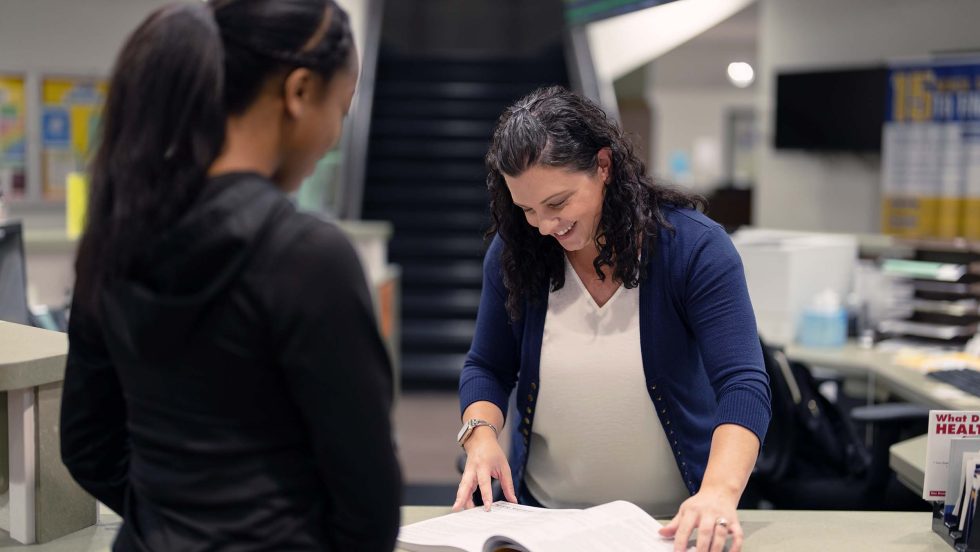One transition all Merced College students must make during the Fall 2022 semester is embracing new Student Success Teams.
The operative word is “teams.”
The Student Success Teams (SST) are the next iteration for campus student support efforts. No longer will each support area—financial aid, basic needs, tutoring, etc.—operate alone.
Now, members of each support group, led by a dean, are assigned to work with faculty and students from seven different academic meta-majors.
The meta-majors, a.k.a. “schools of,” are the School of Industry and Manufacturing; the School of Social Sciences and Education; the School of Science, Technology, Engineering and Mathematics (STEM); the School of Health and Public Safety; the School of Agriculture, the School of Humanities, Languages, Fine and Performing Arts; and the School of Business.
Every student can reach out to their specific team, people they will see regularly and come to know, for help.
“It’s a different way to structure services, to make sure we have timely communication with students,” Dean of Student Services Brooke Boeding said. “Students will realize they have a team behind them, and we’ll see greater levels of success from them.”
INSPIRATION
Boeding said colleges have historically used the Extended Opportunity Programs and Services (EOPS) model—a 52-year old initiative of the California Community Colleges system—to reach students who face the most difficulties getting an education.
“EOPS is ‘high touch’ with lots of services and constant communication between the counselors and students to ensure they get through,” she said. “We first looked at EOPS to see how we could make it something the entire college population could benefit from.”
Merced College has been building on the idea of support teams for over three years, starting with defining guided pathways for each school.
“The state mandated that [in 2015] so all colleges would streamline their services to eliminate confusion and get students on the right path, right away,” Boeding said.
COUNSELING
The college then took steps to embed counseling services—following the Student Success initiative—into the Success Team model, where counselors work with a specific group of students. Counselors gain a more nuanced understanding of students’ life experiences and ambitions, and tailor their interventions with those in mind.
The college restructured its counseling operations around three tiers of need:
- high-need students who don’t have enough services;
- medium-need students with some academic trouble who haven’t yet asked for tutoring; and
- low-need students who have a good plan, but SST still reaches out so they know their team cares.
Jazmin Serrano, a counselor in Los Banos, said one longstanding issue for students has been meeting a different counselor every time they come in for advice.
A dedicated set of counselors for each school will make students feel more connected. It will be a high-touch approach, sans the handholding.
“We’re not chasing information for them, but connecting them with the person they should know and should be working with,” Serrano said.
Counselors are paying close attention right now to making sure multi-major students get placed in the right school for their needs. Counselors are also taking this time to plan workshops and visit classes to introduce themselves, Serrano said.
TECHNOLOGY
The college built a technology hub with an alert system for these interactions throughout 2021. Then faculty were trained on how to use the Early Alert system during the summer of 2022.
Jennifer Edrington, Student Services Area Administrative Coordinator, spearheaded the work to shape the Navigate software for SST purposes.
“We’ve designed each Early Alert based on what needs to happen, which intervention and which outcome,” Edrington said.
Navigate, first, sorts all students into their respective teams and sets a schedule of emails that remind students, for example, to enroll for the upcoming semester or apply for financial aid. Then, during the semester, faculty can send early alerts asking the team to get a student help with basic needs, tutoring, mental health, etc.
“It’s a holistic approach,” Edrington said. “And, at the end, we can measure the effectiveness of the alerts themselves. That’s the key to the new system—the alerts plus data.”
Last month, Serrano was already receiving feedback from professors in Los Banos wondering if alerts were reaching their targets and if their students followed up.
“They want to know they’re not just checking a box,” Edrington said. “They ask for updates. We can’t report back using names [due to the Family Educational Rights and Privacy Act], but the system makes it easy for us to see trends and to report aggregate data.”
Everyone will quickly know what is working.
“All of these support services have been here for a long time, but we never had a way to streamline the process, and then look back at it so quickly to see if it’s working,” Edrington said. “Navigate will do that for us.”
PROGRESS
Boeding knows the idea behind SST will evolve. She expects team members to do plenty of troubleshooting this semester.
Still, Serrano knows the college is onto something.
“We’ve had so many students within the learning communities we now use at Los Banos that are doing well,” she said.
“They are so effective for first-generation and underrepresented student populations. … Even though we’re now doing this on a much broader scale, we still hope students take advantage of it and appreciate it. We hope it makes navigating higher education easier.”
